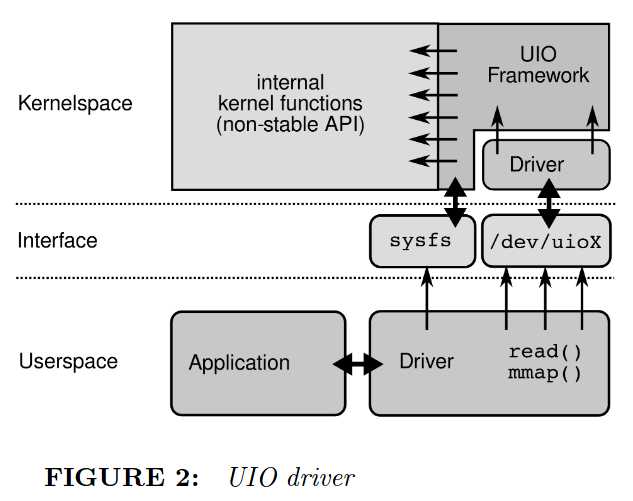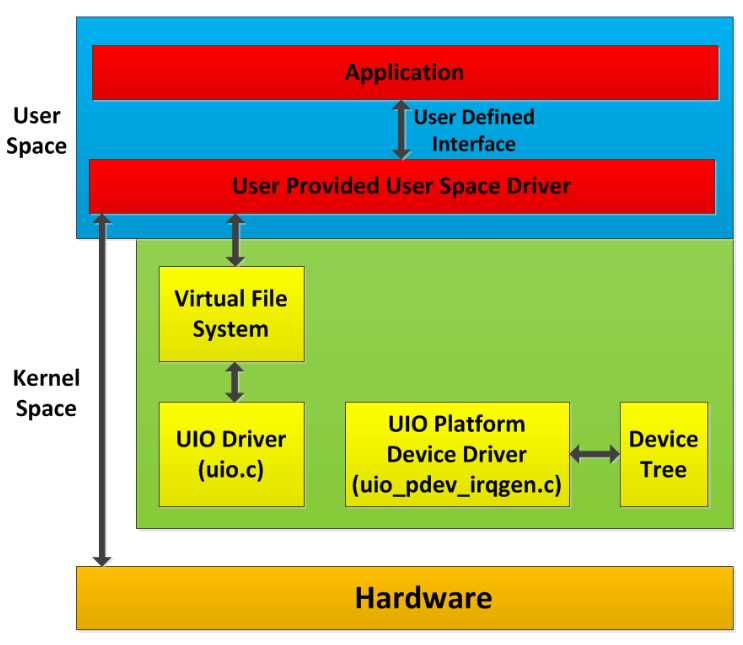标签:fatal 用户空间 uri can duplicate 调用 only 内存 text
注: 要进一步搞清楚SSD盘对应的PCI的BAR寄存器的映射,有必要先了解一下UIO(Userspace I/O)。
UIO(Userspace I/O)是运行在用户空间的I/O技术。在Linux系统中,一般的设备驱动都是运行在内核空间,而在用户空间使用应用程序调用即可。而UIO则是将设备驱动的很少一部分运行在内核空间,而在用户空间实现驱动的绝大多数功能。那么,在内核空间UIO要做的事情就变得很简单,分为两种:
- 分配和记录设备需要的资源和注册UIO设备
- 实现必须在内核空间实现的中断处理函数
为了对UIO有一个直观的认识,先上个图:

了解了UIO 驱动在Linux系统中的位置后,让我们对参考资料(Linux User Space Device Drivers)的部分内容做一个中英文对照翻译以加深对UIO的理解。
1 Device Driver Architectures | 设备驱动架构
- Linux device drivers are typically designed as kernel drivers running in kernel space
- User space I/O is another alternative device driver architecture that has been supported by the Linux kernel since 2.6.24
- People in the Linux kernel community may not always agree on the need to have user space I/O
- Industrial I/O cards have been taking advantage of user space I/O for quite some time
- For some types of devices, creating a Linux kernel driver may be overkill
- Soft IP for FPGAs can have unique requirements that don‘t always fit the mold
2 Legacy User Space Driver Methods (/dev/mem) | 传统的用户态驱动实现方法(/dev/mem)
- A character driver referred to as /dev/mem exists in the kernel that will map device memory into user space
- With this driver user space applications can access device memory
- Memory access can be disabled in the kernel configuration as this is a big security hole (CONFIG_STRICT_DEVMEM)
- Must be root user
- A great tool for prototyping or maybe testing new hardware, but is not considered to be an acceptable production solution for a user space device driver
- Since it can map any address into user space a buggy user space driver could crash the kernel
3 Introduction to UIO | UIO概述
- The Linux kernel provides a framework for doing user space drivers called UIO
- The framework is a character mode kernel driver (in drivers/uio) which runs as a layer under a user space driver
- UIO helps to offload some of the work to develop a driver
- The "U" in UIO is not for universal
- - Devices well handled by kernel frameworks should ideally stay in the kernel (if you ask many kernel developers)
- - Networking is one area where semiconductor vendors are doing user space I/O to get improved performance
- UIO handles simple device drivers really well
- - Simple driver: Device access and interrupt processing with no need to access kernel frameworks
4 Kernel Space Driver Characteristics | 内核空间驱动的特点
4.1 Advantages | 优点
- Runs in kernel space in the highest privilege mode to allow access to interrupts and hardware resources
- There are a lot of kernel services such that kernel space drivers can be designed for complex devices
- The kernel provides an API to user space which allows multiple applications to access a kernel space driver simultaneously
- - Larger and more scalable software systems can be architected
- Many drivers tend to be kernel space
- - Asking questions in the open source community is going to be easier
- - Pushing drivers to the open source community is likely easier
4.2 Disadvantages | 缺点
- System call overhead to access drivers
- - A switch from user space to kernel space (and back) is required
- - Overhead can be non-deterministic having impact on real time applications
- Challenging learning curve for developers
- - The kernel API is different from the application level API such that it takes time to become productive
- Bugs can be fatal causing a kernel crash
- Challenging to debug
- - Kernel code is highly optimized and there are different debug tools
- Frequent kernel API changes
- - Kernel drivers built for one kernel version may not build for another
5 User Space Device Driver Characteristics | 用户空间驱动的特点
5.1 Advantages | 优点
- Less challenging to debug as debug tools are more readily available and common to normal application development
- User space services such as floating point are available
- Device access is very efficient as there is no system call required
- The application API of Linux is very stable
- The driver can be written in any language, not just "C"
5.2 Disadvantages | 缺点
- No access to the kernel frameworks and services
- - Contiguous memory allocation, direct cache control, and DMA are not available
- - May have to duplicate kernel code or use a kernel driver to supplement
- Interrupt handling cannot be done in user space
- - It must be handled by a kernel driver which notifies user space causing some delay
- There is no predefined API to allow applications to access the device driver
- - Concurrency must also be considered if multiple applications access a driver
6 UIO Framework Features | UIO框架的特性
- There are two distinct UIO device drivers provided by Linux in drivers/uio
- UIO Driver (drivers/uio.c)
- - For more advanced users as a minimal kernel space driver is required to setup the UIO framework
- - This is the most universal and likely to handle all situations since the kernel space driver can be very custom
- - The majority of work can be accomplished in the user space driver
- UIO Platform Device Driver (drivers/uio_pdev_irqgen.c)
- This driver augments the UIO driver such that no kernel space driver is required
- It provides the required kernel space driver for uio
- It works with device tree making it easy to use
- The device tree node for the device needs to use "generic uio" in it‘s compatible
- Best starting point since no kernel space code is needed
7 UIO Driver Kernel Configuration | 支持UIO驱动所需要的内核配置
- UIO drivers must be configured in the Linux kernel
CONFIG_UIO=y
CONFIG_UIO_PDRV_GENIRQ=y
8 UIO Platform Device Driver Details | UIO平台服务驱动详解
- The user provides only a user space driver
- The UIO platform device driver configures from the device tree and registers a UIO device
- The user space driver has direct access to the hardware
- The user space driver gets notified of an interrupt by reading the UIO device file descriptor

9 Kernel UIO API - Sys Filesystem
- The UIO driver in the kernel creates file attributes in the sys filesystem describing the UIO device
- /sys/class/uio is the root directory for all the file attributes
- A separate numbered directory structure is created under /sys/class/uio for each UIO device
- - First UIO device: /sys/class/uio/uio0
- - /sys/class/uio/uio0/name contains the name of the device which correlates to the name in the uio_info structure
- - /sys/class/uio/uio0/maps is a directory that has all the memory ranges for the device
- - Each numbered map directory has attributes to describe the device memory including the address, name, offset and size
- /sys/class/uio/uio0/maps/map0
10 User Space Driver Flow | 用户态驱动工作流程
- 01 - The kernel space UIO device driver(s) must be loaded before the user space driver is started (if using modules)
- 02 - The user space application is started and the UIO device file is opened (/dev/uioX where X is 0, 1, 2 ...)
- - From user space, the UIO device is a device node in the file system just like any other device
- 03 - The device memory address information is found from the relevant sysfs directory, only the size is needed
- 04 - The device memory is mapped into the process address space by calling the mmap() function of the UIO driver
- 05 - The application accesses the device hardware to control the device
- 06 - The device memory is unmapped by calling munmap()
- 07 - The UIO device file is closed
11 User Space Driver Example | 用户态驱动示例
1 #define UIO_SIZE "/sys/class/uio/uio0/maps/map0/size"
2
3 int main(int argc, char **argv)
4 {
5 int uio_fd;
6 unsigned int uio_size;
7 FILE *size_fp;
8 void *base_address;
9
10 /*
11 * 1. Open the UIO device so that it is ready to use
12 */
13 uio_fd = open("/dev/uio0", O_RDWR);
14
15 /*
16 * 2. Get the size of the memory region from the size sysfs file
17 * attribute
18 */
19 size_fp = fopen(UIO_SIZE, O_RDONLY);
20 fscanf(size_fp, "0x%08X", &uio_size);
21
22 /*
23 * 3. Map the device registers into the process address space so they
24 * are directly accessible
25 */
26 base_address = mmap(NULL, uio_size,
27 PROT_READ|PROT_WRITE,
28 MAP_SHARED, uio_fd, 0);
29
30 // Access to the hardware can now occur ...
31
32 /*
33 * 4. Unmap the device registers to finish
34 */
35 munmap(base_address, uio_size);
36
37 ...
38 }
12 Mapping Device Memory Details | 设备内存映射详解
- The character device driver framework of Linux provides the ability to map device memory into a user space process address space
- A character driver may implement the mmap() function which a user space application can call
。。。TBD。。。
参考资料
Send a wise man on an errand, and say nothing to him. | 智者当差,无须交待。
[SPDK/NVMe存储技术分析]007 - 初识UIO
标签:fatal 用户空间 uri can duplicate 调用 only 内存 text
原文地址:http://www.cnblogs.com/vlhn/p/7761869.html

